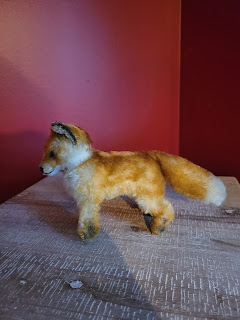Hi - came across this little guy and thought he was cute - intrigued by the made in US Zone Germany tag located on the back of his right leg seam so I started researching and now I am wondering if he is vintage Steiff? He does not have a button or flag or anything identifying him as Steiff. He is approximately 6 inches from tail to end with another 3 inches for his tail. His head is articulated. He appears to be made of mohair and I am not sure what the filling is but it is very firm and stiff. Here are some pictures. Thank you!"
This sweet field and forest friend was indeed made by Steiff, and is one of the most beloved early post war designs amongst collectors today. This fox pattern is known for its great coloring, big fuzzy tail, and really appealing presentation. These foxes come to life with realistic airbrushed highlights on their feet, ears, and faces. Each is detailed with brown and black glass pupil eyes, a black hand embroidered nose and mouth, and a bit of pink airbrushing to on their lips. This legacy pattern was produced in 10, 14, and 17 cm from 1950-1957. The smallest size is unjointed while the medium and larger sized ones are head jointed. The example under discussion today is most likely the medium or 14 cm version.
 The "US Zone Tag" has an interesting story behind it. At the end of WWll, the Allied powers divided Germany west of the Oder-Neisse line into four areas: American, British, French, and Soviet occupational zones.The Americans were responsible for the southern part of Germany, which is where Steiff is located. The forces were tasked at "demilitarizing" Germany, which included shutting down many factories that did, or had the potential to produce items that could be used for combat or aggressive purposes.
The "US Zone Tag" has an interesting story behind it. At the end of WWll, the Allied powers divided Germany west of the Oder-Neisse line into four areas: American, British, French, and Soviet occupational zones.The Americans were responsible for the southern part of Germany, which is where Steiff is located. The forces were tasked at "demilitarizing" Germany, which included shutting down many factories that did, or had the potential to produce items that could be used for combat or aggressive purposes. When Steiff's very limited postwar production slowly started up again in 1945 - 1946, items could only be sold to the American troops. These restrictions were gradually eased and by 1947 Steiff could sell domestically; by 1949 the company's products were once again available internationally. The "US Zone Tag" insured to the outside world that items produced in Germany were done so in a "civilian" factory and met business and distribution standards set up by the American military government overseeing the occupational zone.
Steiffgal hopes this discussion on this mystery fox has been an engaging tail for you!











